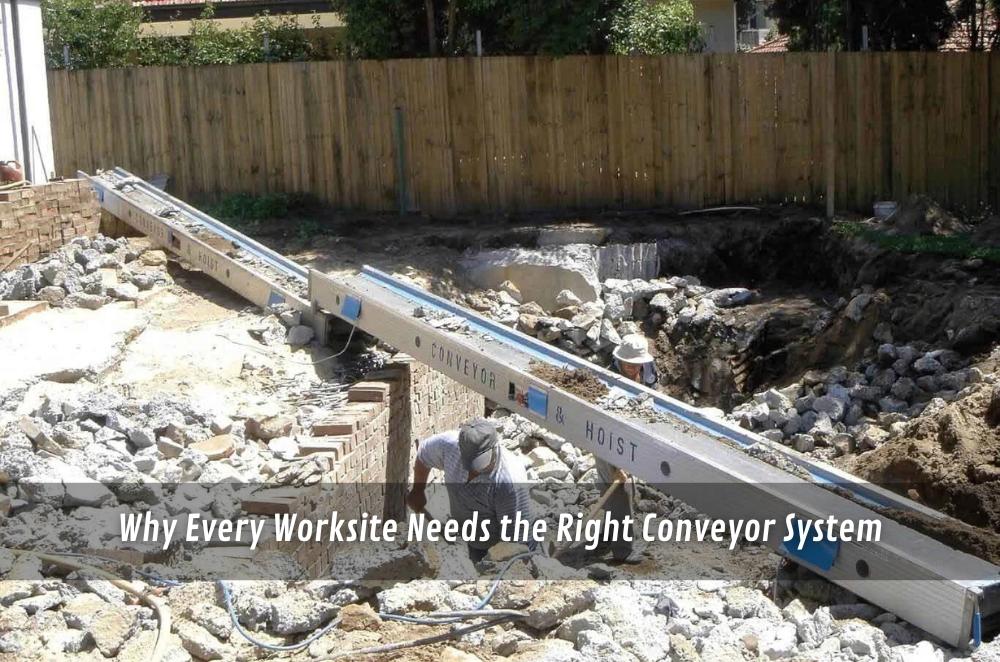Why Every Worksite Needs the Right Conveyor System

On most worksites I’ve visited, the problem is the same: too much effort spent on lifting and shifting, and not enough energy left for the actual job. By lunchtime, you’ll see people rubbing their backs or dragging their feet. It doesn’t take long before fatigue turns into mistakes or worse, injuries.
That’s why equipment that takes the pressure off makes such a difference. Something as simple as bringing in a conveyor for hire can change how a site runs from day one. It doesn’t need to be a major investment or a permanent fixture — even a temporary setup gives crews the support they need to keep loads moving without draining themselves. I’ve seen teams go from struggling to keep pace to cruising through the shift because the conveyor absorbed the hard labour. It’s practical, straightforward, and it just works.
Why choosing the right conveyor matters
Not all conveyors do the same job. Some sites need belts, others need rollers, and others still need something custom to fit into a messy space. I remember a warehouse where people were dragging cable reels by hand across polished concrete. It was a nightmare — slow, loud, and dangerous. Once we rolled in a basic set of gravity rollers, the mood changed instantly. Suddenly, two people could move what used to take four, and no one was bent double by the end of the shift.
A few things I’ve noticed over time:
-
Roller conveyors move heavy gear with almost no effort.
-
Belt conveyors keep loose or awkward items steady.
-
Modular designs flex with changing layouts.
-
Custom builds handle the odd jobs others can’t.
The trick is not just “getting a conveyor” but picking the one that fits the work. Get it wrong and it just sits there. Get it right and the whole site runs smoother.
Linking conveyors to workplace safety obligations
Workplace rules in Australia aren’t just paperwork. They’re there because real people get hurt when jobs aren’t designed properly. I’ve seen too many blokes and women sidelined by injuries that never fully healed. The focus on manual handling safety is about avoiding those exact situations — reducing the lifts, the awkward reaches, the twisting that wrecks shoulders and backs.
A conveyor takes a lot of that risk out of the picture. Instead of three people straining to push a pallet, one can guide the load while the conveyor does the grunt work. It’s not glamorous, but it’s the difference between going home sore and going home fine. And on a busy site, that adds up fast.
The ongoing evolution of conveyor systems
The conveyors I first worked with were basic — steel rollers, loud enough that you had to raise your voice just to be heard, and prone to jamming if loads weren’t lined up properly. Over the years, though, I’ve watched the gear change in big ways. These shifts aren’t just cosmetic; they’ve genuinely reshaped how crews handle day-to-day work. You can see it in the advancements in conveyor systems that have made them more adaptable, safer, and far easier to fit into busy sites.
A few shifts I’ve noticed:
-
Sensors adjust speed so loads don’t pile up.
-
Quieter materials that don’t drown out voices on the floor.
-
Modular setups that grow as workloads grow.
-
Systems that link into software so managers see progress in real time.
The end result? Crews spend less time fighting with equipment and more time keeping things moving. It feels more like a partner in the work than just a bit of steel bolted to the ground.
How conveyors support safer manual handling
People often think conveyors are only about speed, but the bigger impact is in how they reduce strain on the body. I’ve been on sites where workers spent hours bent awkwardly, dragging boxes or hauling loads across long stretches of concrete. It’s the sort of work that wears people down fast. Once conveyors are introduced, those awkward, high-risk movements just aren’t needed anymore.
That’s the real benefit of safe manual handling with conveyors, the heavy lifting gets passed to the system, while workers simply guide things along. Instead of carrying or pushing with all their strength, they make small, manageable adjustments. The difference is immediate: fewer sore backs, steadier shifts, and crews who still have energy left at the end of the day. Over time, it’s the kind of change that protects people’s health while keeping productivity strong.
The ripple effect on workplace culture
There’s something else people often miss. It isn’t just about shifting materials faster or reducing injury risk. Once conveyors are in place, the whole mood of a worksite can shift. I’ve seen crews become more willing to collaborate because they weren’t so worn down by physical strain. Conversations change too — instead of talking about sore backs, people talk about getting through a shift smoother, or even finishing early.
-
Workers build trust in management when equipment clearly supports their well-being.
-
Efficiency gains give staff more control over their pace.
-
Lower strain means fewer frustrations and blow-ups between team members.
-
Sites with good systems tend to attract and hold onto skilled workers.
These aren’t minor changes. A safer, less draining work environment doesn’t just keep people healthy — it builds loyalty and pride. And that culture, more than anything, keeps a site running strong over the long haul.
Final thoughts
A conveyor isn’t just a tool to move stuff around. It’s a quiet backbone of safer, smarter work. Whether it’s a short-term hire to get through a peak season or a long-term system built into the floor plan, the effect is the same: less strain, smoother operations, and people who can focus on doing their jobs well.
In the end, the right conveyor system doesn’t just move boxes. It keeps the work — and the workers — steady. And that’s what keeps a site running strong.






